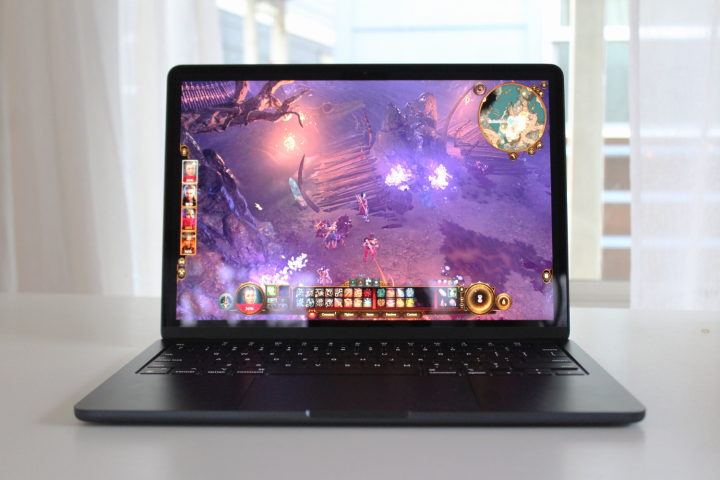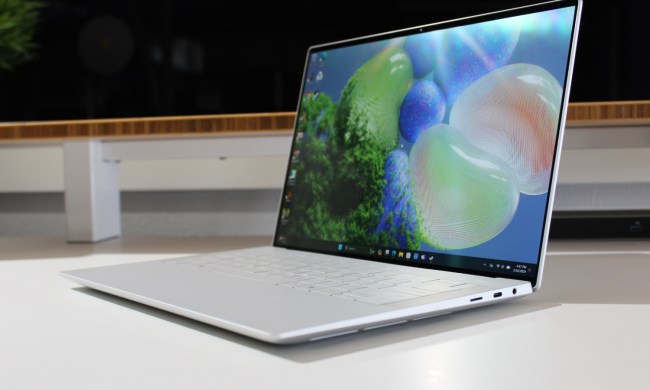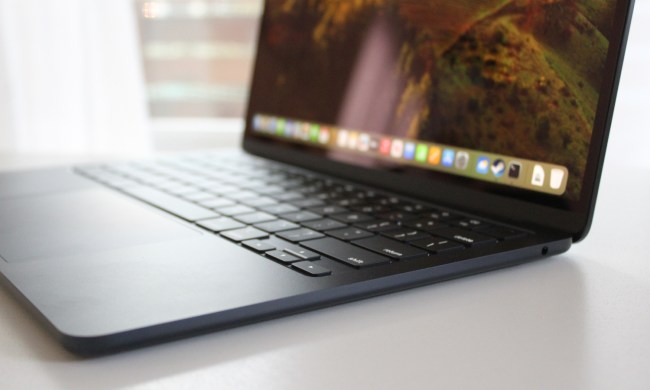
Apple’s MacBook Air M3 represents the latest of the company’s very successful thin-and-light laptops built around Apple Silicon’s fast and highly efficient chipsets. It’s one of the best laptops made, and Windows machines have had a hard time keeping up.
Now, Intel has introduced a new chipset, the Core Ultra Series 2, also know as Lunar Lake, that aims to rectify things with much better efficiency. The Asus Zenbook S 14 is one of the first laptops introduced with the new chipset. Can it compete?
Specs and configurations
| Asus Zenbook S 14 (UX5406SA) | Apple MacBook Air M3 | |
| Dimensions | 12.22 x 8.45 x 0.47-0.51 inches | 11.97 inches x 8.46 inches x 0.44 inches |
| Weight | 2.65 pounds | 2.7 pounds |
| CPU | Intel Core Ultra 7 258V | Apple M3 (8-core) |
| GPU | Intel Arc 140V | 8 GPU cores 10 GPU cores |
| RAM | 16GB LPDDR5X RAM 32GB LPDDR5X RAM |
8GB 16GB 24GB |
| Display | 14.0-inch 2.8K (2880 x 1800) OLED, 120Hz | 13.6-inch 16:10 Liquid Retina (2560 x 1664) IPS |
| Storage | 1TB M.2 NVMe SSD | 256GB SSD 512GB SSD 1TB SSD 2TB SSD |
| Ports | 2 x USB-C with Thunderbolt 4 1 x USB-A 3.2 Gen 2 1 x HDMI 2.1 1 x 3.5mm headphone jack |
2 x USB-C with Thunderbolt 4 1 x 3.5mm audio jack 1 x MagSafe 3 |
| Touch | Yes | No |
| Wireless | Wi-Fi 7 Bluetooth 5.4 |
Wi-Fi 6E Bluetooth 5.3 |
| Webcam | 1080p with infrared camera for Windows 11 Hello | 1080p |
| Battery | 72 watt-hour | 52.6 watt-hours |
| Operating system | Windows 11 | macOS Sonoma |
| Price | $1,399+ | $1,099+ |
| Rating | 4 out of 5 stars | 4 out of 5 stars |
There aren’t many configurations of the Zenbook S 14 available yet. Our review unit costs $1,500 with an Intel Core Ultra 7 258V chipset, 32GB of RAM, a 1TB SSD, and a 14-inch 2.8K OLED display.
The MacBook Air M3 has several options. The base model costs $1,099 with an 8-core CPU/8-core GPU M3 chipset, 8GB of RAM, a 256GB, and a 13.6-inch 2560 x 1664 IPS display. RAM and storage upgrades include $200 to upgrade to 16GB or 512GB, and $400 to go to 24GB and 1TB. An upgrade to 2TB is a whopping $800. Our review unit cost $1,699 for an 8-core CPU/10-core GPU M3, 16GB of RAM, and a 1TB SSD. The high-end configuration with 24GB of RAM and a 2TB SSD is $2,299.
So, when configured similarly, the MacBook Air M3 is $100 more. That makes them close enough that other factors will weigh more.
Design

The MacBook Air M3 is an incredibly thin laptop while still maintaining Apple’s usual excellent build quality and solid chassis. It’s CNC machined out of a single chunk of aluminum, and it’s an elegant aesthetic in one of four colors. The Zenbook S 14 is a pretty thin laptop as well, and it uses a “ceraluminum” (Asus’ word) material to be very light and yet sturdy. It’s a good-looking laptop as well, coming in either dark gray or white and with a geometric pattern on the lid.
Both laptops have the usual quality hinge that opens with one hand, and while the MacBook Air feels dense and cold in hand, the Zenbook has a warm texture. The bottom line is that nobody is likely to buy either laptop based solely on their look and feel.
The Zenbook S 14 has the very good Asus keyboard that you’ll find on the entire ZenBook line. It has plenty of spacing and large keycaps, as well as light and snappy switches. The MacBook Air uses Apple’s excellent Magic Keyboard, which is my favorite. It has a perfect layout, comfortable keys, and the most precise switches on a laptop today. The Zenbook’s mechanical touchpad feels Ok, but it’s almost too large, leaving a very small palm rest. The MacBook Air’s Force Touch haptic touchpad is perfectly sized and works great, with the Force Click function that adds additional features with a firmer “click.” The keyboard and touchpad are Apple strengths.
Connectivity favors the Zenbook S 14, which has a couple of legacy ports to go with the same two Thunderbolt 4 connections. And it has more up-to-date wireless connectivity. Both laptops have 1080p webcams, and the Zenbook uses an infrared camera with Windows 11 facial recognition compared to the MacBook Air’s Touch ID fingerprint reader. The Zenbook supports Studio Effects software that enhances videoconferencing.
Performance

Intel’s Lunar Lake chipsets are aimed at competing directly with Apple Silicon. We reviewed the Zenbook S 14 with the Core Ultra 7 258V, a 17-watt, 8-core (four Performance and four Low Power Efficient), 8-thread chipset. It uses the newest Intel Arc 140V integrated graphics. The MacBook Air uses Apple’s M3 chipset with eight CPU cores and eight or 10 GPU cores. We reviewed the faster version.
In our benchmarks, the MacBook Air M3 was faster in all but the Handbrake test. It was faster in both single-core and multi-core tests. And its GPU was more than twice as fast in the 3DMark Wild Life Extreme benchmark.
It’s not that the Zenbook S 14 is a slow laptop. It’s just that the MacBook Air M3 is meaningfully faster.
| Geekbench 6 (single/multi) |
Cinebench R24 (single/multi/battery) |
Handbrake | 3DMark Wild Life Extreme |
|
| Asus Zenbook S 14 (Core Ultra 7 258V / Intel Arc 140V) |
2,738 / 10,734 | 112 / 452 | 113 | 3,240 |
| Apple MacBook Air M3 (M3 8/10) |
3,102 / 12,078 | 141 / 601 | 109 | 8,098 |
Display

The Zenbook S 14 uses a 14-inch 2.8K OLED display running at up to 120Hz. It’s a lovely display with OLED’s usual bright, dynamic colors and inky blacks. That compares to the MacBook Air’s 13.6-inch 2560 x 1664 IPS display running at 60Hz.
While the MacBook Air’s display is a very good example of IPS technology, and it’s very bright and reasonably colorful, the Zenbook’s OLED panel has much wider colors and near-perfect blacks. Our review unit had oddly poor color accuracy, but that’s unusual and likely an outlier. The Zenbook’s display will be appreciated by creators and media consumers.
| Asus Zenbook S 14 (OLED) |
Apple MacBook Air M3 (IPS) |
|
| Brightness (nits) |
313 | 496 |
| AdobeRGB gamut | 95% | 87% |
| sRGB gamut | 100% | 100% |
| DCI-P3 gamut | 100% | 99% |
| Accuracy (DeltaE, lower is better) |
4.92 | 1.24 |
| Contrast | 28,310:1 | 1,480:1 |
Portability

The MacBook Air is the thinnest laptop you can buy, and the Zenbook S 14 is only a little thicker. In spite of having a larger display, the Zenbook is around the same width and depth, and it weighs about the same. These are both very portably laptops.
When it comes to battery life, the Zenbook S 14 comes about as close to the MacBook Air M3 as any recent Windows laptop has managed. It’s only three hours behind in our web-browsing test and an hour behind in our video-looping test. And the two laptops managed about the same in the demanding Cinebench R24 multi-core test.
| Web | Video | Cinebench R24 |
|
| Asus Zenbook S 14 (Core Ultra 7 258V / Intel Arc 140V) |
16 hours, 47 minutes | 18 hours, 35 minutes | 3 hour, 33 minutes |
| Apple MacBook Air M3 (M3 8/10) |
19 hours, 38 minutes | 19 hours, 39 minutes | 3 hours, 27 minutes |
Two very good laptops, but the MacBook Air wins a close one
These are both great laptops. The Zenbook S 14 leverages the Intel Lunar Lake chipset for great battery life, which is an early win for the platform. It’s a nicely designed and built laptop, and it really doesn’t have any significant flaws.
The MacBook Air is also close to perfect, and it’s meaningfully faster with slightly better battery life. It has a much better keyboard and touchpad, and generally a very elegant design. It’s a bit more expensive, but worth it — although if you must have Windows, then the Zenbook S 14 is a great choice.


